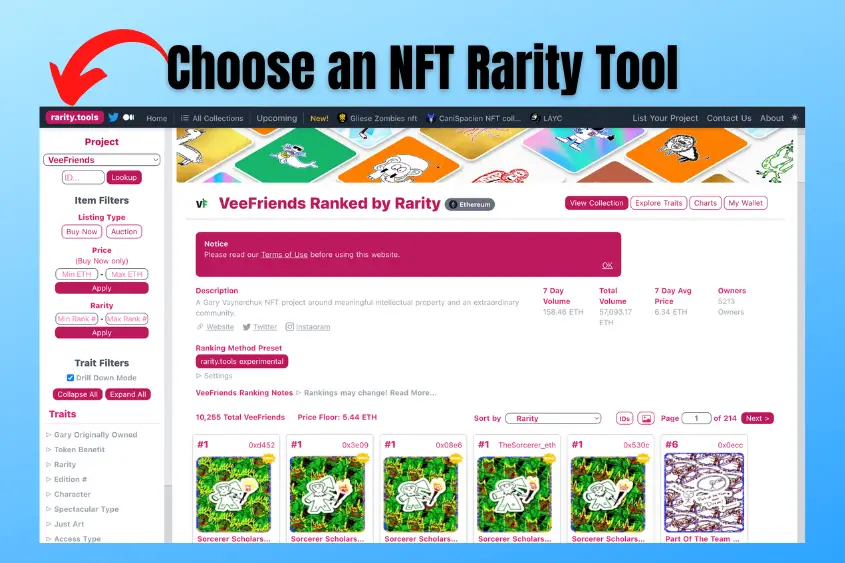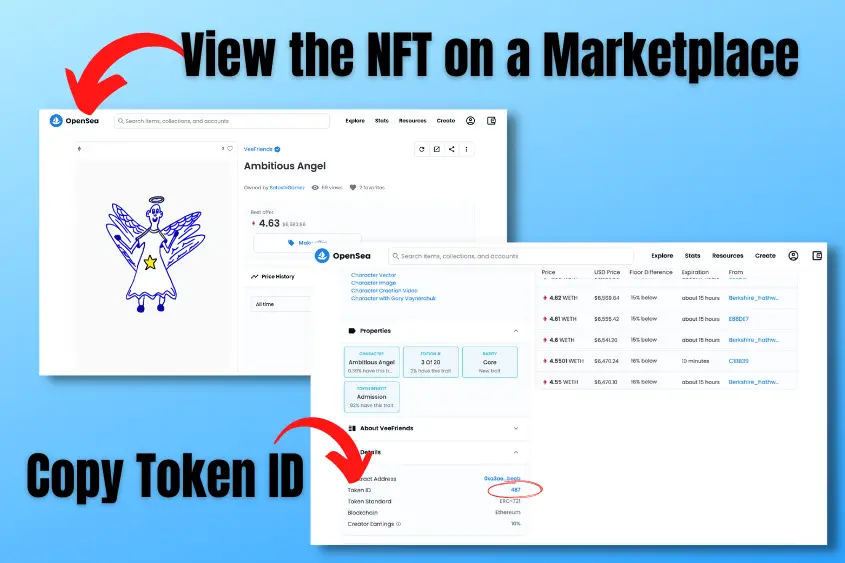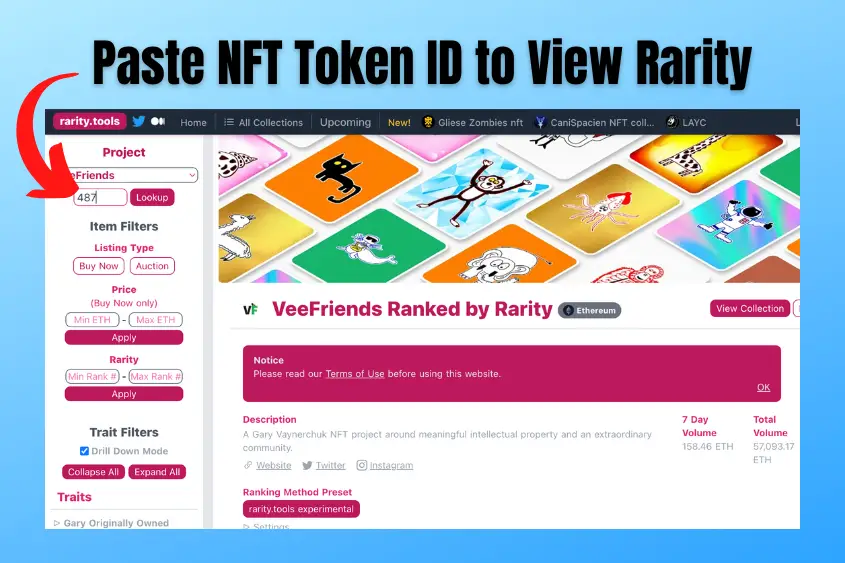Knowing how to check NFT rarity is vital to find the most valuable NFTs in a collection, and at the best price. Although rarity isn’t the only thing that makes an NFT valuable, it’s still essential in a community that values the rarity of certain digital assets.
How to Check NFT Rarity
Checking the rarity of an NFT is easy and the process is similar regardless of which NFT rarity tool you use. To check an NFT’s rarity follow these three simple steps.
1. Find an NFT or Collection You Want to Check
When it comes to checking the rarity of an NFT, you can either check an individual NFT or you can view the entire collection to locate various rarity scores within your preferred range.

So first, you need to determine whether you want to quickly find the rarity of one specific NFT (maybe it’s one you already own) or if you want to scan an entire collection to find the rarest NFT (perhaps you’re considering buying one).
2. Choose an NFT Rarity Tool
Once you locate an individual NFT or entire collection that you want to check the rarity of, you need to choose a rarity tool.
This can be difficult as there are dozens of different rarity and data analytic tools to choose from.

However, I tested, ranked, and reviewed 21 rarity tools for you so that you can easily find the one that suits your specific needs.
3. Search for the NFT Collection and Enter the NFT’s Token ID
After you find a rarity tool that best suits your needs, search for an NFT collection and enter the token ID of the asset that you want to know the rarity of.

To find an NFT’s token ID, visit an NFT marketplace such as Opensea and search for the NFT in question.
Then, go to Details and copy the Token ID. From there, go back to the NFT rarity tool and enter the token ID into the Token ID field.

This will provide you with the rarity rank, rarity score, and a breakdown of the NFT’s traits.
If you don’t want to know the rarity of a specific NFT but you just want to scan a collection, you can simply search for your desired NFT collection on your rarity tool of choice, and then use the rarity filters to find the NFT you’re looking for.
When scavenging through an NFT collection, there are several filter options to find the exact NFT you want.
Most NFT rarity tools enable you to filter by price, rank, and traits.
This is the quickest way to find NFTs in a collection that fits your budget and rarity rank needs.
Why Check the Rarity of An NFT?
Checking the rarity of an NFT can help you determine the value of a specific NFT within its collection. The rarer an NFT is, the more valuable it is. Likewise, less rare NFTs are less valuable. Ultimately, NFT rarity helps both buyers and sellers assess the price of their digital assets.
Let’s dive deeper into why checking the rarity of an NFT can help both buyers and sellers.
How NFT Rarity Can Help Buyers
Buyers that check the rarity of an NFT can make better purchasing decisions.
For example, if the floor price (entry price) of an NFT collection is 1 ETH, you wouldn’t want to buy the least rare NFT for anything over the floor price.
If you do, you are likely to end up upside down on your investment. The smarter move is to find the rarest NFT for the lowest price.
This leaves more room for market fluctuations and can potentially lead to more profit since your NFT is considered more valuable.
How NFT Rarity Can Help Sellers
Sellers looking to list their NFT benefit from checking rarity to better determine a fair market price to list their assets at.
For example, if the floor price of a collection is 1 ETH and you own the rarest NFT, you wouldn’t want to list it at the floor price.
Rather, you want to list it on the higher end of the spectrum since your NFT is the most valuable.
By listing your NFT without first checking its rarity rank, you are potentially leaving money on the table.
To help you determine the best price to sell your NFT for, you can check other NFTs in the same collection that have a similar rarity rank, and look at how much they are listed for and the prices they’ve been selling for.
Not only will this help you pocket the most cash, but it will help you sell your NFT faster.
How Is NFT Rarity Calculated?
The best NFT rarity calculation method is called Rarity Score. This method assumes the rarity score for a trait value equals 1, then divides the number of NFTs with that trait value by the total number of NFTs in a collection. Hence, the total rarity score is the sum of the rarity score of all its trait values.
Nonetheless, there are several methods that have been used to calculate NFT rarity including Trait Rarity, Average Rarity, Statistical Rarity, and Rarity Score.
But, several of these methods leave many collectors and investors concerned.
Here’s why.
Trait Rarity
The trait rarity method only compares the rarest trait of each NFT to calculate its overall rarity score.
This doesn’t work well since the calculation doesn’t take into consideration the rarity of every trait and combine them to give an overall rank.
Average Trait Rarity
The average trait rarity calculation gathers the rarity percentage of each trait, adds them together, and then divides it by the total number of traits to provide an overall rarity score.
Although each trait’s rarity is taken into consideration, the problem with this calculation is that it gives too much credit to the rarity of every trait and doesn’t consider the value of a super rare trait, hence diluting the overall rarity rank.
Statistical Rarity
Statistical rarity calculates the overall rarity of an NFT by multiplying all of its trait rarity percentages together.
The problem with statistical rarity is that the NFT’s rarity isn’t really being measured in its specified collection.
For example, if an NFT collection contains a single one-of-one NFT (arguably the rarest) that has the least rare traits (but also has the rarest one-of-one trait), and then you measure that up against another NFT that has rarer traits overall (except for the rarest one-of-one trait), the calculation would say that the NFT with more rare traits would be the rarest of the two.
Who knew calculating NFT rarity would be so hard?
So, what is the best way to calculate an NFT’s rarity?
Rarity Score (Best Rarity Calculation Method)
Rarity score is a calculation method discovered by the founder of Rarity.Tools.
This method is simple and provides the best results in correlation with how collectors perceive the overall value of an NFT:
[Rarity Score for a Trait Value = 1] divided by [Number of Items with that Trait Value] divided by [Total Number of Items in Collection].
This calculation results in the total rarity score of an NFT being the sum of the rarity score of all of its trait values.
That said, the rarity score calculation takes into consideration single rare traits and the overall trait rarities, resulting in a solution that coincides with the expectations of investors and collectors alike.
Final Thoughts
Checking NFT rarity is as simple as knowing which NFT you want to check, finding a rarity tool, and then filtering through various traits or inputting the token ID to discover the rarity of any particular NFT.
Knowing how to check the rarity of NFTs can help both sellers and buyers determine the fairest market value when listing or purchasing an NFT.
If you are still pondering on a tool that’s right for you and your ambitions, make sure to check out my honest review where I test and rank the 21 best rarity tools.

1 thought on “How to Check NFT Rarity (3 Quick and Easy Steps)”
Comments are closed.